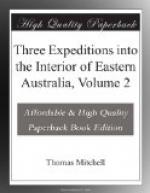TRAP-ROCKS.
Trap-rocks are displayed in a great variety of situations. They often occur connected with limestone in valleys, sometimes constitute lofty ranges as on the north or left bank of the Hunter, and along the seashore at the Illawarra; they likewise cap the summit of isolated hills, but no particular place can be assigned to them with reference to the position of any other rocks. Trap forms a good soil on decomposition as is shown in the rich districts of the Illawarra, Cowpastures, Valley of the Hunter, Liverpool Plains, Wellington Valley, and Buree.
Vesicular lava and amygdaloid are the chief ingredients of some of the best parts of Australia Felix. In that region volcanic phenomena are more apparent than in other parts of Eastern Australia, especially where the Grampians, consisting of a mass of sandstone 4000 feet thick, seem a portion of the great formation covering the districts of the north. The strata in these mountains are inclined to the north-west, as if in obedience to the upheavings of Murroa or Mount Napier, an extinct volcano in the very line of their outcrop.
Observation. We found in the interior, hills of sandstone only, but at this extremity of the great Coast range granite is extensively exposed in ridges, between which, in one extensive district, are round heights of mammeloid form, consisting of pure lava, and in another, tabular masses of trap reposing on granite occupy one side of a valley.
GRAVEL.
Beds of gravel are not common in these parts of Australia; but occur partially in the basins of the larger streams on the interior side of the Coast range where the pebbles in general consist of quartz.
SANDSTONE.
The prevailing geological feature in all Eastern Australia is the great abundance of a ferruginous sandstone in proportion to any other rocks. The sterility of the country where it occurs has been frequently noticed in these volumes. It is found on the coast at Port Jackson and it was the furthest rock seen by me in the interior beyond the Darling.
A deposit upwards of 1200 feet thick forms the Blue Mountains west of Sydney, ranging thence, with the intersection of no other rock of importance, to the Hawkesbury; and although declining towards the sea at the rate of only 100 feet per mile, or 1 in 52, or at an angle of about 1 degree with the horizon; yet it is traversed by ravines which increase in depth in proportion as the sandstone attains a greater elevation, and present perpendicular crags and cliffs of a very remarkable character.
A region consisting of a sandstone deposit of so great thickness and so slightly inclined necessarily presents a monotonous aspect in all directions; and when it is compared with European countries composed of many formations and presenting great diversity of scenery it proves how much geological structure influences pictorial and physical outlines. (See Plate 10 Volume 1, also Plate 38 above.)




